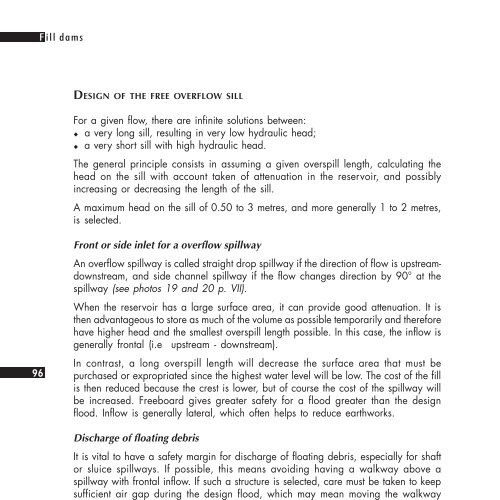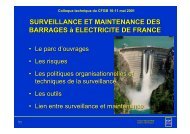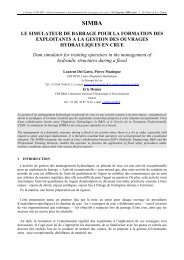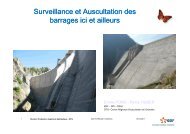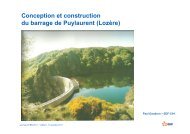SMALL DAMS
SMALL DAMS - Comité Français des Barrages et Réservoirs
SMALL DAMS - Comité Français des Barrages et Réservoirs
- No tags were found...
You also want an ePaper? Increase the reach of your titles
YUMPU automatically turns print PDFs into web optimized ePapers that Google loves.
F ill dams<br />
DESIGN OF THE FREE OVERFLOW SILL<br />
For a given flow, there are infinite solutions between:<br />
!"a very long sill, resulting in very low hydraulic head;<br />
!"a very short sill with high hydraulic head.<br />
The general principle consists in assuming a given overspill length, calculating the<br />
head on the sill with account taken of attenuation in the reservoir, and possibly<br />
increasing or decreasing the length of the sill.<br />
A maximum head on the sill of 0.50 to 3 metres, and more generally 1 to 2 metres,<br />
is selected.<br />
96<br />
Front or side inlet for a overflow spillway<br />
An overflow spillway is called straight drop spillway if the direction of flow is upstreamdownstream,<br />
and side channel spillway if the flow changes direction by 90° at the<br />
spillway (see photos 19 and 20 p. VII).<br />
When the reservoir has a large surface area, it can provide good attenuation. It is<br />
then advantageous to store as much of the volume as possible temporarily and therefore<br />
have higher head and the smallest overspill length possible. In this case, the inflow is<br />
generally frontal (i.e upstream - downstream).<br />
In contrast, a long overspill length will decrease the surface area that must be<br />
purchased or expropriated since the highest water level will be low. The cost of the fill<br />
is then reduced because the crest is lower, but of course the cost of the spillway will<br />
be increased. Freeboard gives greater safety for a flood greater than the design<br />
flood. Inflow is generally lateral, which often helps to reduce earthworks.<br />
Discharge of floating debris<br />
It is vital to have a safety margin for discharge of floating debris, especially for shaft<br />
or sluice spillways. If possible, this means avoiding having a walkway above a<br />
spillway with frontal inflow. If such a structure is selected, care must be taken to keep<br />
sufficient air gap during the design flood, which may mean moving the walkway<br />
towards the downstream side of the sill (or the contrary). Finally, as a last recourse,<br />
the walkway could be designed to be washed away.<br />
When the catchment area is wooded, trees may be torn away from the banks during<br />
strong floods. This possibility becomes a certainty during exceptional floods. But<br />
experience has shown that a lot of other floating debris can arrive in front of the<br />
spillway, in particular trailers!<br />
The minimum dimensions that can be recommended to discharge such debris are as<br />
follows:<br />
!"sill length of 10 - 15 metres between piers;<br />
!"air gap 1.5 to 2 metres under a walkway or a bridge;<br />
!"shaft 6 to 8 metres in diameter.


